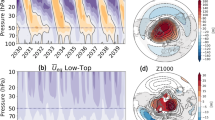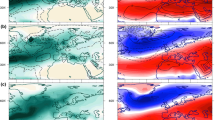Abstract
To investigate the effect of Greenland’s orography on the northern hemisphere winter circulation experiments with an atmospheric GCM are conducted: a perturbed integration where standard orography is reduced to sea level in the Greenland area is compared to a standard orography control integration. The outcome of these experiments suggests that the existence of high mountains at Greenland causes a reinforcement of the stationary wave field in the Atlantic sector, colder temperatures to the west of Greenland and warmer temperatures to the east and south, over the North Atlantic. The impact on the flow field cannot be understood in the framework of standing Rossby waves, but it indicates a resonance between remotely forced stationary waves and local (thermo-) dynamics. The pattern of the North Atlantic Oscillation (NAO), in particular the northern centre, lies further to the east in the flat-Greenland experiment compared to the control run and the observations. Together with the fact that the climatological low-pressure system around Iceland hardly shifts, this suggests that the location of the NAO is not necessarily tied to the time mean pressure distributions. Considering the model resolution as a parameter, experiments with a high resolution (T106) suggest that the near-field changes are represented sufficiently by a T42 resolution, a standard resolution used in state-of-the-art coupled climate models. In contrast, far-field changes depend critically on model resolution. Hemispheric circulation and temperature changes differ substantially from low to high resolution, and generalized statements about the impact of Greenland’s orography cannot be made.








Similar content being viewed by others
References
Ambaum MHP, Hoskins BJ, Stephenson DB (2001) Arctic Oscillation or North Atlantic Oscillation. J Climate 14:3495–3507
Bacher A, Oberhuber JM, Roeckner E (1998) ENSO dynamics and seasonal cycle in the tropical Pacific as simulated by the ECHAM4 / OPYC3 coupled general circulation model. Clim Dyn 14:431–450
Blender R, Fraedrich K, Lunkeit F (1997) Identification of cyclone track regimes in the North Atlantic. Quart J R Met Soc 123:727–741
Charney J, Eliassen A (1949) A numerical model for prediciting the perturbations of the middle latitude westerlies Tellus 1:38–54
Christoph M, Ulbrich U, Oberhuber JM, Roeckner E (2000) The Role of Ocean Dynamics for Low-Frequency Fluctuations of the NAO in a Coupled Ocean-Atmosphere GCM. J Climate 13:2536–2549
Crowley TJ, Baum SK (1995) Is the Greenland Ice Sheet bistable?. Paleoceanography 10:357–363
Dong B, Valdes PJ (2000) Climates at the Last Glacial Maximum: Influence of Model Horizontal Resolution. J Climate 13:1554–1573
Gregory JM, Huybrechts P, Raper SCB (2004) Threatened loss of the Greenland ice-sheet. Nature 428:616
Held IM (1983) Stationary and quasi-stationary eddies in the extratropical troposphere. In: Hoskins BJ, Pearce DP (eds) Large-Scale dynamical processes in the atmosphere. Academic Press, London pp 127–168
Hoskins B, Karoly DJ (1981) The steady linear response of a spherical atmosphere to thermal and orographic forcing. J Atmos Sci 38:1179–1196
Kristjánsson JE, McInnes H (1999) The impact of Greenland on cyclone evolution in the North Atlantic. Quart J R Met Soc 125:2819–2834
Lau N (1988) Variability of the observed midlatitude storm tracks in relation to low-frequency changes in the circulation pattern. J Atmos Sci 45:2718–2743
Marshall J, Kushnir Y, Battisti D, Chang P, Czaja A, Dickson R, Hurrell J, McCartney M, Saravanan R, Visbeck M (2001) North Atlantic climate variability: phenomena, impacts and mechanisms. Int J Climat 21:1863–1898
May W (2001) Impact of horizontal resolution on the simulation of seasonal climate in the Atlantic/European area for present and future times. Climate Research 16:203–223
Merkel U, Latif M (2002) A High Resolution AGCM Study of the El Niño Impact on the North Atlantic/European Sector. Geophys Res Lett 29:10.1029
Petersen GN, Kristjánsson JE, Ólafsson H (2004) Greenland and the northern hemisphere winter circulation. Tellus A 56:102–111
Plumb RA (1985) On the three-dimensional propagation of stationary waves. J Atmos Sci 42:217–229
Ringler TD, Cook KH (1995) Orographically induced stationary waves: dependence on latitude. J Atmos Sci 52:2548–2560
Roeckner E, Arpe K, Bengtsson L, Christoph M, Claussen M, Dümenil L, Esch M, Giorgetta M, Schlese U, Schulzweida U (1996) The atmospheric general circulation model ECHAM-4 Tech rep. Max-Planck-Institut für Meteorologie, Hamburg
Rogers JC (1990) Patterns of low-frequency monthly sea level pressure variability (1899-1986) and associated wave cyclone frequencies. J Climate 3:1364–1379
Rogers JC (1997) North Atlantic storm track variability and its association to the North Atlantic Oscillation and climate variability of northern Europe. J Climate 10:1635–1647
Schwierz CB (2001) Interactions of Greenland-scale orography and extra-tropical synoptic-scale flow Tech rep. Swiss Federal Institute of Technology, Zurich, Switzerland
Seager R, Battisti DS, Yin J, Gordon N, Naik N, Clement AC, Cane MA (2002) Is the Gulf Stream responsible for Europe’s mild winters?. Quart J R Met Soc 128:2569–2586
Sickmöller M, Blender R, Fraedrich K (2000) Observed winter cyclone tracks in the northern hemisphere in re-analysed ECMWF data. Quart J R Met Soc 126:591–620
Thompson DWJ, Wallace JM (2000) Annular modes in the extratropical circulation Part I: month-to-month variability. J Climate 13:1000–1016
Toniazzo T, Gregory JM, Huybrechts P (2004) Climatic Impact of a Greenland Deglaciation and Its Possible Irreversibility. J Climate 17:21–33
Ulbrich U, Christoph M (1999) A shift of the NAO and increasing storm track activity over Europe due to anthropogenic greenhouse gas forcing. Clim Dyn 15:551–559
Wallace M, Gutzler G (1981) Teleconnections in the geopotential height field during the northern hemisphere winter. Mon Weath Rev 109:784–128
Acknowledgements
We are greatly indebted to the Model and Data group, Hamburg, for providing the reanalysis data (ECMWF/DWD/DKRZ: 1996). We would like to thank the two anonymous reviewers for their constructive suggestions and comments on the manuscript. They helped to improve the presentation of our results. We thank Rita Seiffert for providing the cyclone-track statistics. This work was funded by the Deutsche Forschungsgemeinschaft (DFG) within the Sonderforschungsbereich 512: Tiefdruckgebiete und Klimasystem des Nordatlantiks.
Author information
Authors and Affiliations
Corresponding author
Rights and permissions
About this article
Cite this article
Junge, M.M., Blender, R., Fraedrich, K. et al. A world without Greenland: impacts on the Northern Hemisphere winter circulation in low- and high-resolution models. Clim Dyn 24, 297–307 (2005). https://doi.org/10.1007/s00382-004-0501-2
Received:
Accepted:
Published:
Issue Date:
DOI: https://doi.org/10.1007/s00382-004-0501-2




